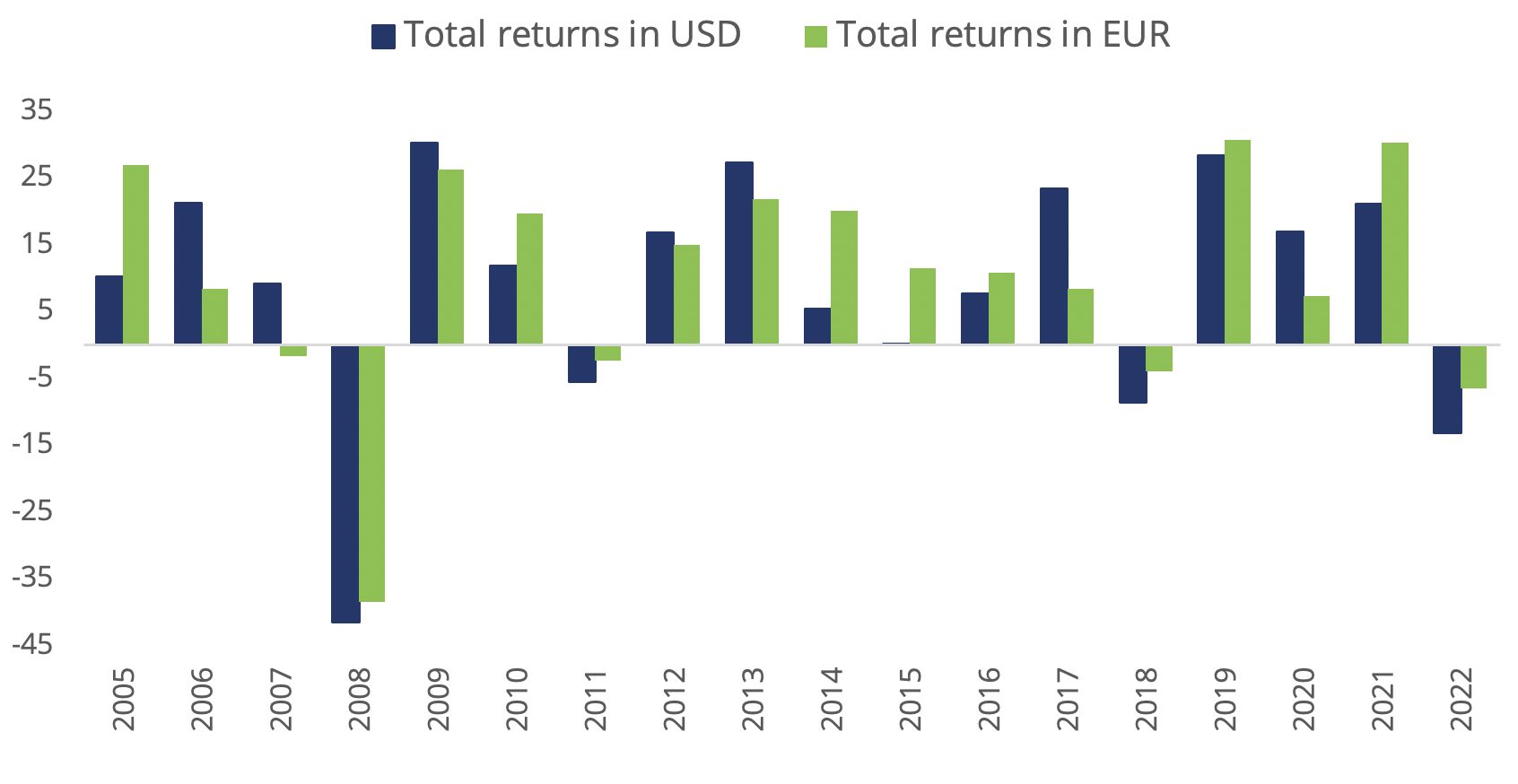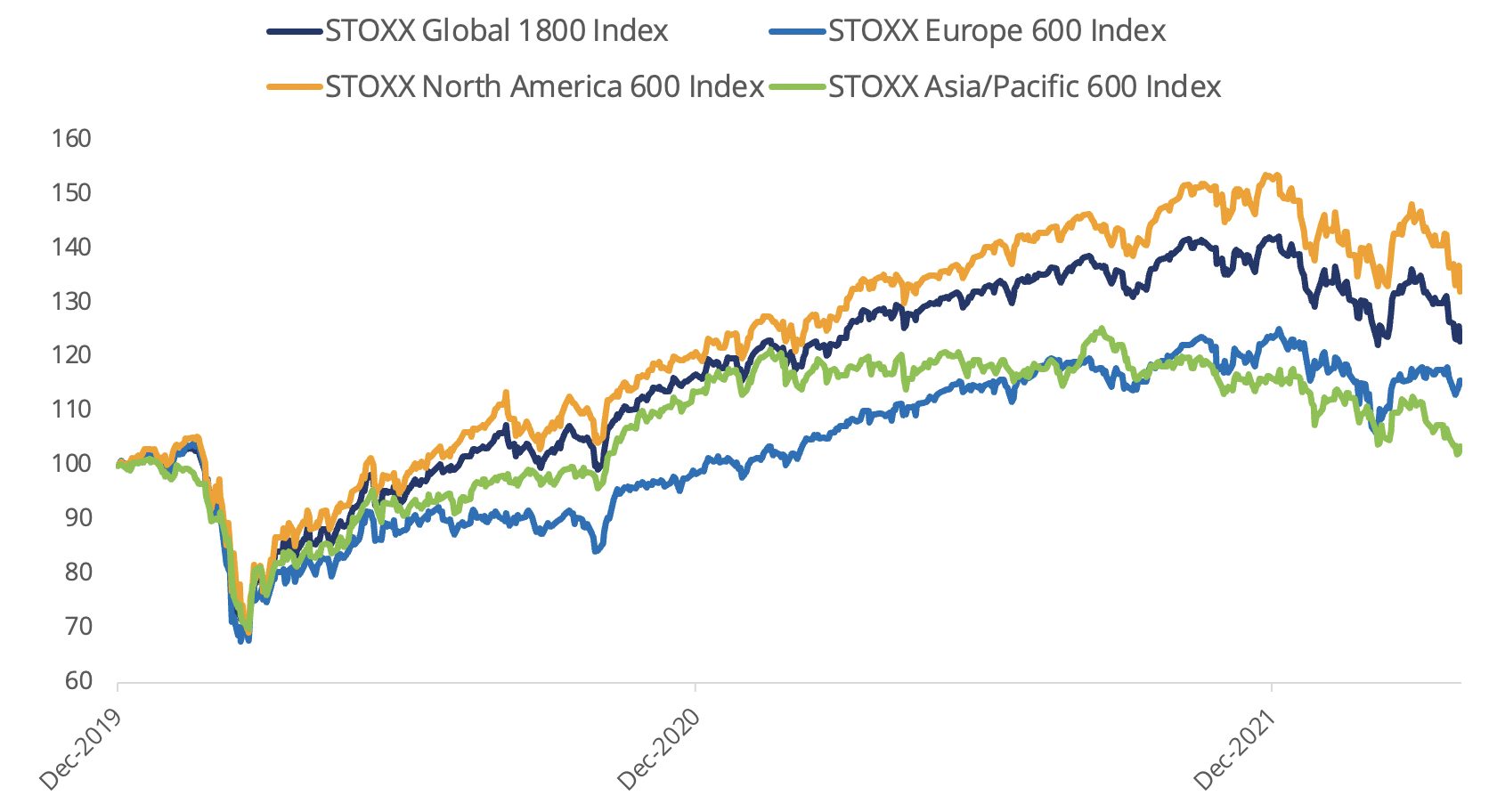
Stocks tumbled in April by the most since the onset of the COVID-19 pandemic as investors’ expectations grew that the Federal Reserve and other central banks will need to raise interest rates faster and higher to fight inflation. US consumer-discretionary and technology shares suffered the worst of the rout.
The STOXX® Global 1800 index lost 8.2% last month when measured in dollars and including dividends,1 its steepest monthly retreat since March 2020. The benchmark fell 3.2% in euros as the greenback rose 5.2% against the common currency.
The STOXX® North America 600 fell 8.9% in dollars and the STOXX® USA 500 lost 9.1%.2 Europe fared significantly better, with the pan-European STOXX® Europe 600 dropping 0.6% in euros and the Eurozone’s EURO STOXX 50® decreasing 2%. The STOXX® Asia/Pacific 600 declined 7.6% in dollars.
Figure 1: Benchmark indices’ April risk and return characteristics

Fed Chairman Jerome Powell said on April 21 that the central bank could raise interest rates by 50 basis points in May, as it finally did on May 4, as it moves “a little more quickly” to combat prices that are rising at the fastest pace in years.3 The Fed has turned more hawkish in recent months, acknowledging that accelerating inflation may not be a temporary phenomenon but something that may last longer than previously thought.
Investors, meanwhile, found little support in some of the biggest companies’ first-quarter earnings releases during the month. Netflix Inc. and Amazon.com Inc. were among companies whose shares plunged after reporting disappointing profit statements or outlooks.
| For a complete review of all indices’ performance last month, visit our April index newsletter. |
The STOXX Global 1800 posted in 2021 its third consecutive double-digit annual advance and has now gained in nine of the past ten years. Returns have amounted to an average of 13.9% per year over the last decade.
Figure 2: Annual % returns for STOXX Global 1800 index

Figure 3: Returns since January 1, 2020

Volatility rises slightly
The EURO STOXX 50® Volatility (VSTOXX®), which tracks EURO STOXX 50 options prices, rose to 30.8 at the end of last month from 29 in March. A higher VSTOXX reading suggests investors are paying up for puts that offer insurance against stock price drops. The VDAX-New®, which tracks volatility in German equities, climbed to 29.8 from 29.3 in March.
Developed and emerging markets
All 25 developed markets tracked by STOXX retreated during April when measured in dollars. The STOXX® Developed Markets 2400 index slid 8.2% in dollars and 3.2% in euros.
All but three of 20 national developing markets dropped in the month on a dollar basis. The STOXX® Emerging Markets 1500 index declined 6% in the US currency and lost 0.9% in euros.
Media index leads losses in month
Eighteen of 20 Supersectors in the STOXX Global 1800 fell in the month. The STOXX® Global 1800 Media (-21.7% )4 led losses after streaming company Netflix reported it lost subscribers in the first three months of this year. At the other end, the STOXX® Global 1800 Food, Beverage and Tobacco posted a 1.8% advance.
US technology in worst month since global financial crisis
The STOXX® USA 900 Consumer Discretionary Index fell 13%, the worst among 11 industries, paced by losses in Amazon.com. It was closely followed by the STOXX® USA 900 Technology Index (-12.9%), which recorded its worst month since November 2008.
Factor investing
All factor strategies covering global markets beat the STOXX Global 1800 benchmark, except for Momentum, according to the STOXX Factor indices. The STOXX® Global 1800 Ax Momentum fell 10.4% during the month.
Figure 4: STOXX Factor (Global) indices’ April risk and return characteristics

Climate benchmarks
Among climate benchmarks, the STOXX® Global 1800 Paris-Aligned Benchmark (PAB) fell 8.1% and the STOXX® Global 1800 Climate Transition Benchmark (CTB) retreated 8%. The PAB and CTB indices follow the requirements outlined by the European Commission’s climate benchmarks regulation.
The STOXX® Willis Towers Watson World Climate Transition Index fell 9% in April. The STOXX Willis Towers Watson Climate Transition Indices (CTIs) were introduced in October 2021. They employ a unique Climate Transition Value at Risk (CTVaR) methodology that quantifies the anticipated impact of an economic transition on equity valuations. The CTIs look beyond carbon emissions and make a forward-looking, bottom-up evaluation of asset repricing risks in a decarbonization pathway.
Among the STOXX Low Carbon indices, the EURO STOXX 50® Low Carbon (-2.5%) trailed the EURO STOXX 50 by 48 basis points in April. Elsewhere, the STOXX® Global Climate Change Leaders (-5.8%), which selects corporate leaders that are publicly committed to reducing their carbon footprint, outperformed the STOXX Global 1800 index by more than 2 percentage points last month.
ESG-X and ESG indices
The STOXX® Global 1800 ESG-X index lost 8.3%. The STOXX® ESG-X indices are versions of traditional, market-capitalization-weighted benchmarks that observe standard responsible exclusions of leading asset owners.
Within indices that combine exclusions and ESG best-in-class integration, the EURO STOXX 50® ESG index (-2%) performed in line with its benchmark during April. Germany’s DAX® 50 ESG index (-2.3%), which excludes companies involved in controversial activities and integrates ESG scoring into stock selection, slightly underperformed the benchmark DAX® (-2.2%).
Sustainability indices
Among other STOXX sustainability families, the STOXX® Global 1800 ESG Broad Market index lost 8.1% in the month. The STOXX ESG Broad Market indices apply a set of compliance, product involvement and ESG performance exclusionary screens on a starting benchmark universe until only the 80% top ESG-rated constituents remain.
The STOXX® Global 1800 ESG Target also fell 8.1%, the EURO STOXX® ESG Target lost 1.9% and the DAX® ESG Target dropped 2.2%. The STOXX and DAX ESG Target indices seek to significantly improve the benchmark portfolio’s ESG profile while mirroring its returns as closely as possible. The indices implement, through a series of constraints, an optimization process to maximize the overall ESG score of the portfolio while constraining the tracking error to the benchmark.
Finally, the STOXX® Global 1800 SRI dropped 7.5%, beating its benchmark. The STOXX SRI indices apply a rigorous set of carbon emission intensity, compliance and involvement screens, and track the best ESG performers in each industry group within a selection of STOXX benchmarks.
Thematic indices
There were poor performances relative to the benchmark from the STOXX® Thematic indices in the month that ended. The indices seek exposure to the economic upside of disruptive global megatrends and follow two approaches: revenue-based and artificial-intelligence-driven.
Eighteen of the 23 revenue-based thematic indices underperformed the STOXX Global 1800. The STOXX® USA ETF Industry (-14.4%) was the group’s worst performer.
Among the STOXX artificial-intelligence-driven thematic indices, the STOXX® AI Global Artificial Intelligence index (-10.2%) and its ADTV5 version (-10.2%) underperformed the STOXX Global 1800 index during April, as did the iSTOXX® Yewno Developed Markets Blockchain index (-9.8%).
Dividend strategies
Dividend strategies, on the other hand, outperformed benchmarks last month. The STOXX® Global Maximum Dividend 40 (-6.1%) selects only the highest-dividend-yielding stocks. The STOXX® Global Select Dividend 100 (-5.2%), meanwhile, tracks companies with sizeable dividends but also applies a quality filter such as a history of stable payments.
Minimum variance
Minimum variance strategies also outperformed. The STOXX® Global 1800 Minimum Variance fell 4.1% and the STOXX® Global 1800 Minimum Variance Unconstrained lost 2.8%. The STOXX® Europe 600 Minimum Variance index advanced 1.4%, while its unconstrained version gained 2.8%.
The STOXX Minimum Variance Indices come in two versions. A constrained version has similar exposure to its market-capitalization-weighted benchmark but with lower risk. The unconstrained version, on the other hand, has more freedom to fulfill its minimum variance mandate within the same universe of stocks.
1 All results are total returns before taxes unless specified.
2 Throughout the article, all European indices are quoted in euros, while global, North America, US, Japan and Asia/Pacific indices are in dollars.
3 CNBC, ‘Powell says taming inflation ‘absolutely essential,’ and a 50 basis point hike possible for May,’ April 21, 2022.
4 Figures in parentheses show last month’s gross returns.



